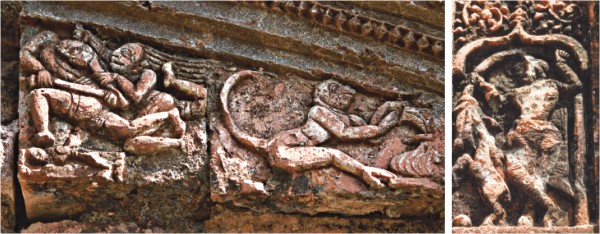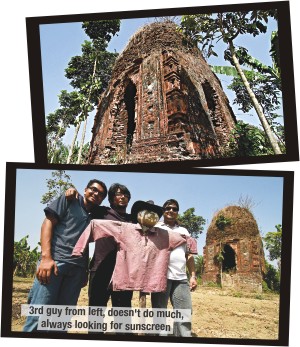

Tale of the Stolen Terracotta  Plaques
Plaques
By Anika Ali &
Adnan M. S. Fakir
Photos courtesy of Finding Bangladesh
Recently a bunch of archaeologists were squinting really hard as they stood before Dhopadi Math at Baro Bazaar. They were trying to understand how old this establishment is.
Most of the Math [read motth not mathematics] has already suffered the destructive forces of natural erosion. Even the parts that are upright today look like they are ready to crumble away to oblivion.
With very little known about the Math, tracing its date of origin is a puzzle. The archaeologists that we mentioned earlier must have given up and gone off since no official date of construction has been documented. Of course such tasks are better left for the Sherlocks of our land. Our research team at Finding Bangladesh HQ, did some heavy reading and discovered that the Math was built in the Sultanate period which began in 1206. They also found out that when Khan Jahan Ali (pbuh) visited Baro Bazaar in 1418, the Math was still standing there. So the Math must have been built sometime between 1206 and 1418. Geniuses, aren't we?
Our resources also allowed us to catch a sneak peek into the Math's past. Even though parts of the Math have now been reduced to dust, books written about it say that an impressive row of terracotta plaques once adorned the elaborate and expansive body of the Math. Today, only 13 of these beautiful terracotta plaques are still hanging there. Curiously, all 13 of the surviving terracotta plaques are visibly placed on the front wall. So where are the rest? Our first guess is stolen and sold in the black market to private and foreign collectors for thousands of dollars. Sadly, you can bet that this is precisely what happened.
The illustrations on the terracotta plaques are more brilliant. There are pictures of ducks, elephants, a pretty woman carrying a hand-fan and two memorable scenes from the epic poem, Ramayana. One of them is an image of Sita during her famous exile. The remaining plaques bear a series of images which combine to narrate a touching story depicting bromance of divine standards.
The story goes that Lakshmana was once fatally wounded at the Great War [for those who haven't read the Ramayana, it's the one against Ravana, not Germany]. The only way to save him was to treat his wound before the following dawn. But the wound could only be cured by a specific herb found on the Dronagiri Mountain in the Himalayas. Needless to say, the mountain was very far away. The Hindu deity, Hanuman came to the rescue.
He journeyed to the Himalayas overnight and found the Dronagiri Mountain. However, he couldn't figure out which herb on the mountain was the one that he needed. Well, so what? Hanuman lifted the whole mountain and returned to Lakshmana with it. Lakshmana's physician and rishi, Sushena, picked the right herb from that mountain and brewed up a medicine. Thus, Lakshmana was saved. While only a part of the story can be read from the remaining terracottas, our hunch is that the entire story was once depicted through the plaques, including the famous fight against Ravana. Excuse us while we throw an angry look at the Government for not looking after this gorgeous monument.
For more stories involving deities and lifted mountains, visit www.facebook.com/findingbangladesh.
